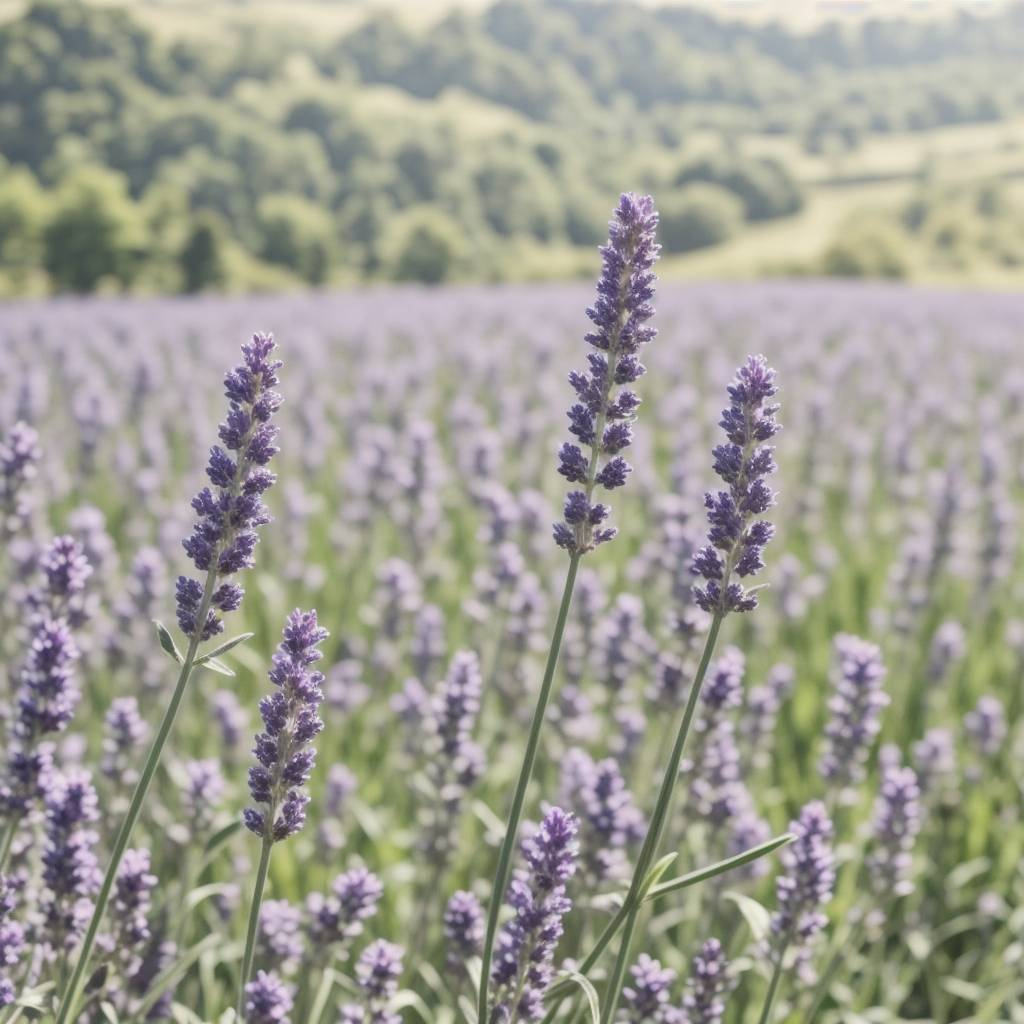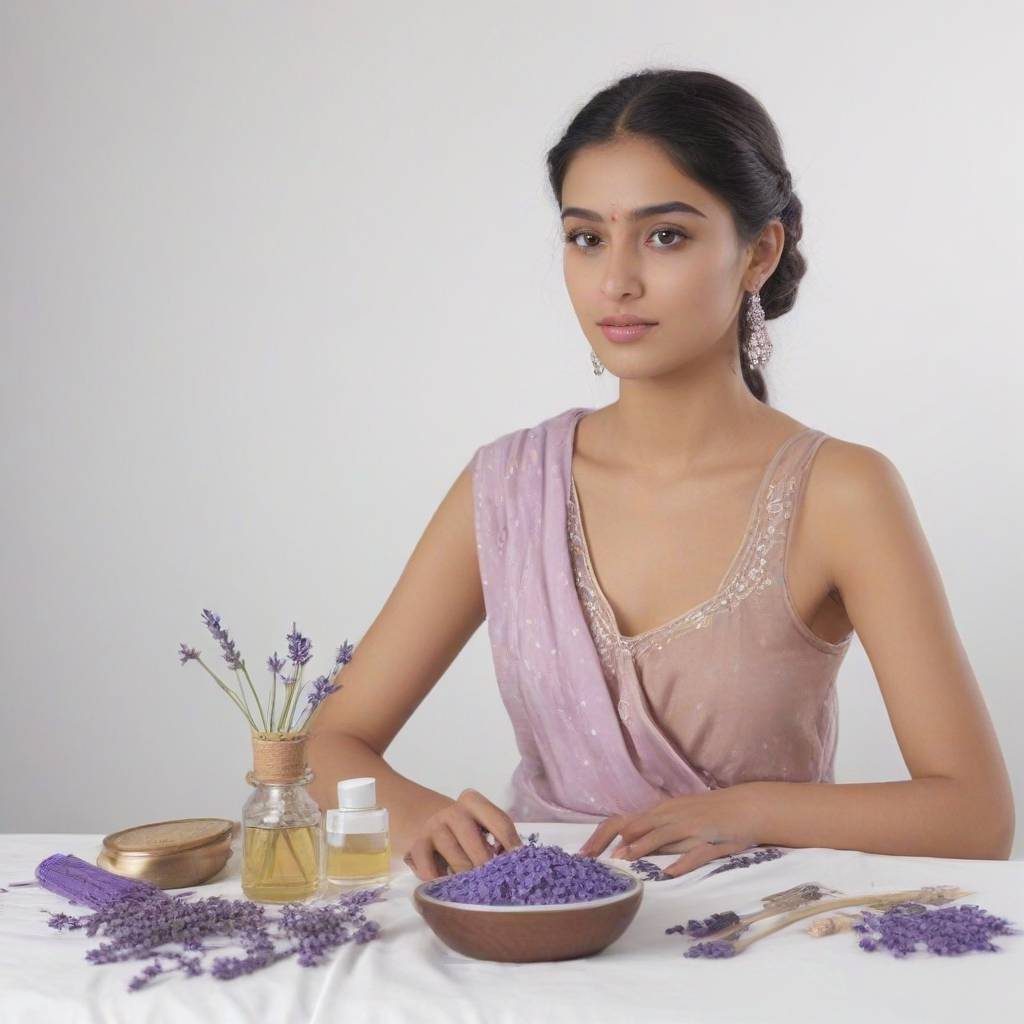
Lavender, scientifically known as Lavandula, is a genus of flowering plants in the mint family, Lamiaceae. Native to the Mediterranean, lavender is celebrated for its fragrant flowers, which are used in aromatherapy, cosmetics, and culinary dishes. The plant’s soothing aroma and beautiful purple blooms make it a popular choice for gardens and landscapes. There are over 45 species of lavender, each with unique characteristics and uses. Below are detailed descriptions of few most popular types of it, and Lavender Gardening Basics and uses. Let’s Explore it with Zardens.
English Lavender (Lavandula angustifolia)
English Lavender stands out for its sweet fragrance and hardy nature. This type thrives in various climates, making it a favorite among gardeners. Its narrow leaves and compact flower spikes in shades of purple, blue, and white create a picturesque scene in any garden. English Lavender’s oil, renowned for its calming properties, finds use in aromatherapy, cosmetics, and culinary arts. This type also attracts bees and butterflies, adding life and vibrancy to your garden. Plant English Lavender in well-drained soil and full sun for the best growth. Regular pruning helps maintain its shape and encourages blooming.
- Essential oils, calming
- Hardy, versatile
- Aromatic flowers
- Attracts pollinators
- Well-drained soil
- Regular pruning
French Lavender (Lavandula dentata)
French Lavender captivates with its serrated leaves and distinctive, pineapple-shaped flower heads. This type exudes a slightly camphorous aroma, different from the sweet scent of English Lavender. French Lavender adds a unique texture and fragrance to gardens and containers. This type flourishes in hot, dry climates and blooms almost year-round. Use it to create fragrant borders, hedges, or as a striking container plant. Its essential oil, though less commonly used than English Lavender, still holds value in aromatherapy and crafts.
- Serrated leaves
- Camphorous aroma
- Hot, dry climates
- Year-round blooms
- Fragrant borders
- Container plant
Subscribe to our newsletter!
Spanish Lavender (Lavandula stoechas)
Spanish Lavender, or Lavandula stoechas, features unique, rabbit-ear-like petals on top of its flower spikes. This variety thrives in Mediterranean climates, tolerating heat and drought conditions well. Spanish Lavender’s strong, herbal fragrance and striking appearance make it a popular choice for ornamental gardens. Its essential oils have antibacterial properties, making it a valuable addition to natural remedies. Spanish Lavender demands well-drained soil and full sun for optimal growth. Use it in rock gardens, borders, or as an accent plant.
- Rabbit-ear petals
- Herbal fragrance
- Mediterranean climates
- Heat tolerant
- Antibacterial oils
- Rock gardens
Lavandin (Lavandula x intermedia)
Lavandin is a hybrid between English Lavender and Portuguese Lavender (Lavandula latifolia). Known for its tall stems and large flower spikes, Lavandin produces a higher yield of essential oil than its parents. Its strong, camphor-like scent is often used in commercial products like soaps, perfumes, and cleaning agents. Lavandin thrives in similar conditions to English Lavender but prefers slightly warmer climates. This type’s robust growth and prolific blooming make it ideal for large-scale planting.
- Hybrid variety
- Tall stems
- Large flower spikes
- High oil yield
- Commercial use
- Warmer climates
Choosing the Right Variety of Lavender
Selecting the perfect lavender variety ensures your garden flourishes with beauty and fragrance. With over 45 species and countless hybrids, making the right choice can seem daunting. Here’s how to find the ideal lavender for your climate, space, and preferences.
English Lavender (Lavandula angustifolia)
If you live in a cooler climate, English lavender is your go-to. Known for its sweet fragrance and hardiness, it thrives in USDA zones 5-8. Popular varieties include ‘Munstead’ and ‘Hidcote,’ both of which produce compact, dense foliage and vibrant purple blooms. English lavender makes an excellent choice for borders, walkways, and containers.
French Lavender (Lavandula dentata)
French lavender prefers warmer, more humid climates, typically thriving in USDA zones 8-11. Distinguished by its toothed leaves and serrated edges, this variety adds a unique texture to your garden. French lavender blooms longer than other types, offering a prolonged display of delicate flowers. Its slightly camphor-like scent is less sweet but equally enchanting.
Spanish Lavender (Lavandula stoechas)
Spanish lavender stands out with its striking, tufted flowers resembling pineapple tops. This variety flourishes in USDA zones 8-9, preferring hot, dry conditions. Known for its unique appearance and strong aroma, Spanish lavender is perfect for adding a touch of the Mediterranean to your garden. Popular varieties include ‘Anouk’ and ‘Otto Quast.
Lavandin (Lavandula x intermedia)
A hybrid of English and Portuguese lavender, Lavandin thrives in USDA zones 5-9 and combines the best traits of both parents. It’s larger and more robust than English lavender, with longer stems and larger flower spikes. Varieties like ‘Grosso’ and ‘Provence’ produce an abundance of highly fragrant flowers, ideal for crafting and essential oil production.
Choosing Based on Space and Use
Consider your garden space and intended use when selecting a variety. For small gardens or containers, compact varieties like ‘Hidcote’ or ‘Munstead’ work well. If you’re looking to create a fragrant hedge, larger types like ‘Grosso’ or ‘Provence’ are excellent choices. For culinary uses, English lavender’s sweeter scent and flavor are preferred.
Mix and Match for Visual Appeal
Don’t hesitate to mix different lavender types for a dynamic, colorful display. Combining varieties can extend your blooming season, enhance fragrance, and create visual interest. Pairing English and French lavender, for example, offers a blend of colors and textures that keep your garden vibrant and aromatic throughout the growing season.
By choosing the right lavender variety, you’ll create a garden that thrives in your climate and meets your aesthetic and practical needs. Embrace the diversity of lavender and enjoy a garden filled with beauty and fragrance year-round.
Planting Lavender: Perfect Timing and Prime Locations
Plant lavender at the perfect time for a flourishing garden. Spring marks the ideal season to start. The last frost has bid farewell, and the soil warms up, welcoming new growth. Late spring ensures your lavender enjoys a full growing season, establishing strong roots before winter’s chill returns. In milder climates, fall planting also works well, giving the roots time to settle without the intense summer heat.
Choose the best location for your lavender to thrive. Lavender adores sunlight, soaking up six to eight hours of direct sun daily. Select a sunny spot in your garden, free from overshadowing trees or structures. Sunshine not only fuels growth but also intensifies the aromatic oils that give lavender its signature scent.
Soil quality matters. Lavender demands well-drained soil, shunning waterlogged roots. Sandy or gravelly soils suit lavender best, but you can enhance drainage in heavier soils by adding organic matter, sand, or small stones. Avoid areas where water collects after rain; lavender prefers its feet dry. Raised beds or slopes offer excellent drainage, making them perfect planting spots.
Spacing impacts your lavender’s health and beauty. Space plants 12-18 inches apart, ensuring good air circulation. Proper spacing prevents mold and mildew, common in tightly packed plants. For larger varieties, like the robust English lavender, consider even wider spacing to accommodate their size.
Mulching your lavender bed keeps weeds at bay and retains soil moisture without suffocating the roots. Use a light gravel mulch instead of organic mulches, which can trap moisture and promote rot. The gravel not only aids drainage but also reflects sunlight, boosting the warmth around your plants.
- Lavender Gardening Basics
- “Manure for Plants: Nature’s Nutrient-Rich Gift”
- “King of Fruits” The Mango: India’s Golden Fruit
- “Landscaping The Art of Beautifying”
- “Edible Plants for small garden” a rewarding experience!
Watering and Feeding Lavender: The Secret to Lush Blooms
Nurturing lavender with the right watering and feeding routine transforms your garden into a fragrant paradise. Start strong by watering newly planted lavender regularly. This consistent hydration helps establish robust roots. However, once your lavender plants settle in, they become remarkably drought-tolerant. Embrace this trait by watering deeply but infrequently. Let the soil dry out between waterings, ensuring the roots get a good soak without sitting in moisture.
Observe your plants closely. Healthy lavender displays vibrant green foliage and abundant blooms. When the leaves start to droop or the color fades, it’s time for a drink. Aim for morning watering sessions, giving the soil ample time to dry out during the day. This practice wards off fungal issues and keeps your lavender happy and thriving.
Feeding lavender requires a delicate touch. Overfeeding leads to lush foliage at the expense of those coveted fragrant flowers. Use a low-nitrogen fertilizer sparingly. Early spring is the ideal time to feed your lavender, providing the nutrients it needs for the growing season ahead. Opt for a balanced, slow-release fertilizer, or enrich the soil with a light application of compost. This gentle feeding regime encourages healthy growth and a bounty of blossoms without overwhelming the plant.
Lavender also loves a little bit of tough love. Remember, it thrives in nutrient-poor soil. So, resist the urge to pamper it excessively. Gravel mulch works wonders, too, keeping weeds at bay and enhancing drainage without retaining too much moisture.
By mastering the art of watering and feeding, you ensure your lavender grows strong, blooms profusely, and fills your garden with its signature scent. Every time you tend to your lavender, envision the gorgeous, aromatic haven you’re cultivating. With the right care, your lavender will reward you with years of beauty and fragrance
Harvesting and Using Lavender: A Guide to Aromatic Bliss
Harvesting lavender transforms your garden into a fragrant treasure trove. Start your day early, choosing a morning when the buds are just beginning to open. The morning sun enhances the essential oils, making the scent more potent. Cut the stems just above the leaves, selecting the longest and most vibrant stalks. Gather the lavender in bundles, tying them with twine or rubber bands. Place these bundles upside down in a cool, dark place to dry. A well-ventilated area ensures the lavender retains its vivid color and intoxicating aroma.
Once your lavender dries, the fun truly begins. Create sachets to tuck into drawers or closets, infusing your clothes with a gentle, soothing fragrance. Fill small fabric bags with dried lavender buds, and tie them securely. These sachets also make delightful, handcrafted gifts that spread relaxation and cheer.
Lavender’s culinary potential surprises many. Incorporate it into your kitchen for a unique twist. Infuse sugar with dried lavender for a floral sweetener perfect for tea, cookies, or scones. Lavender’s delicate flavor pairs beautifully with lemon, honey, and vanilla. Experiment with lavender-infused syrups or honey to drizzle over pancakes, desserts, or cocktails.
Crafting beauty products with lavender adds a touch of luxury to your routine. Create a simple lavender oil by infusing dried buds in a carrier oil, such as almond or jojoba. Use this oil for massages, or add a few drops to your bath for a spa-like experience. Lavender’s calming properties also make it ideal for DIY balms, lotions, and soaps. Mix dried lavender with Epsom salts for a soothing bath soak that eases tension and softens skin.

Uses of lavender
Lavender, renowned for its captivating fragrance and vibrant purple blooms, boasts a versatility that extends far beyond its ornamental beauty. This aromatic herb has been cherished for centuries, finding its way into a myriad of applications that enrich everyday life. From its therapeutic properties and culinary delights to its role in home care and beauty routines, lavender proves to be an indispensable asset. Dive into the diverse uses of lavender and discover how this remarkable plant can enhance your well-being and lifestyle in countless ways.
Lavender in Aromatherapy: A Scented Path to Relaxation
Lavender reigns supreme in the world of aromatherapy. Its calming scent soothes the mind, reduces anxiety, and enhances sleep quality. Imagine coming home after a long, stressful day and lighting a lavender-scented candle. Instantly, the room fills with a tranquil aroma, melting away tension and promoting a peaceful atmosphere.
Many people also use lavender essential oil in diffusers. Just a few drops can transform the ambiance of a room, making it a sanctuary of calm and relaxation. Massage therapists often incorporate lavender oil into their treatments, combining the benefits of touch and scent to alleviate stress and muscle tension.
For those seeking a restful night’s sleep, lavender proves to be a natural remedy. Spraying a lavender mist on pillows or using a lavender-infused sleep mask can significantly improve sleep quality. Its gentle, floral fragrance lulls the mind into a state of tranquility, making it easier to drift into a deep, restorative slumber.
Lavender’s versatility extends beyond relaxation. It can enhance focus and concentration, making it a perfect companion for meditation and yoga practices. By incorporating lavender into your daily routine, you harness the power of aromatherapy to create a serene and balanced life.
Lavender in Skincare: Nature’s Gentle Healer
Lavender works wonders in skincare, offering both beauty and therapeutic benefits. Its natural antiseptic and anti-inflammatory properties make it a valuable ingredient in many skincare products. Imagine applying a lavender-infused moisturizer, feeling its gentle touch as it soothes irritated skin and reduces redness.
Lavender oil helps combat acne by inhibiting bacteria that cause infections. It also unclogs pores and reduces inflammation, making it a gentle yet effective treatment for acne-prone skin. Many people opt for lavender-infused toners to maintain clear and radiant skin, enjoying the refreshing feel and pleasant scent.
For those with sensitive skin, lavender proves to be a calming agent. It alleviates the symptoms of eczema and psoriasis, providing relief from itchiness and discomfort. By incorporating lavender oil into your skincare routine, you nourish your skin with a natural healer.
Lavender also promotes faster healing of cuts, burns, and insect bites. Its antimicrobial properties prevent infection and aid in the skin’s regeneration process. Simply applying diluted lavender oil to minor wounds accelerates healing, leaving the skin smooth and unblemished.
Incorporating lavender into your skincare routine not only enhances your skin’s health but also indulges your senses with its delightful fragrance. Embrace the soothing power of lavender for a naturally beautiful complexion.
Culinary Delights with Lavender: A Flavorful Twist
Lavender adds a unique twist to culinary creations, infusing dishes with a delicate floral flavor. Chefs and home cooks alike celebrate its versatility in both sweet and savory recipes. Imagine sipping on a refreshing lavender lemonade on a hot summer day, the subtle floral notes providing a perfect balance to the tangy lemon.
In baking, lavender elevates cookies, cakes, and pastries with its distinct aroma and taste. Lavender-infused sugar becomes a secret weapon in the kitchen, adding a sophisticated touch to desserts. Picture a lavender honey cake, each bite offering a harmonious blend of sweetness and floral elegance.
Lavender also shines in savory dishes. It pairs beautifully with herbs like rosemary and thyme, enhancing the flavors of roasted meats and vegetables. A lavender herb rub on a roasted chicken creates a fragrant and delicious centerpiece for any meal.
For adventurous mixologists, lavender opens a world of creative cocktail possibilities. A lavender gin and tonic or a lavender martini brings a botanical twist to classic drinks. The floral essence of lavender complements the herbal notes in many spirits, creating a delightful and memorable drinking experience.
Embrace lavender in your culinary adventures to discover new dimensions of flavor. Its unique taste transforms ordinary dishes into extraordinary delights, making every meal a fragrant and flavorful journey.
Lavender and Landscaping
Landscaping turns ordinary spaces into extraordinary outdoor paradises. With thoughtful design and creativity, your yard can become a personal oasis that reflects your style and meets your needs.
Landscaping transforms more than just your yard; it enhances your lifestyle. A well-designed landscape increases your home’s value and provides a serene retreat from the hustle and bustle of daily life. Embrace the potential of your outdoor space and create a landscape that brings joy and inspiration for years to come.
Lavender: The Versatile Gem of Your Garden
Lavender, with its enchanting fragrance and striking purple blooms, stands as a must-have for any garden enthusiast. This hardy perennial doesn’t just bring beauty to your landscape; it also offers a plethora of benefits that make it a garden superstar.
Lavender thrives in well-drained soil and loves basking in full sun. This Mediterranean native flourishes in conditions that would challenge many other plants. Its drought-resistant nature makes it an ideal choice for sustainable gardening. Once established, lavender requires minimal watering, which conserves precious resources and reduces maintenance.
The aesthetic appeal of lavender is undeniable. Plant it along walkways or as a border to create a stunning visual effect. Its silvery-green foliage and vibrant blooms add texture and color, transforming ordinary spaces into picturesque retreats. The blooms, which appear from late spring to early summer, attract bees and butterflies, promoting pollination and enhancing biodiversity in your garden.
Lavender’s uses extend beyond ornamental purposes. Harvest the flowers for a variety of DIY projects. Create fragrant sachets, essential oils, or even culinary delights. Its calming scent also serves as a natural stress reliever, making your garden a sanctuary of tranquility.
Incorporate lavender into your landscape design to enjoy its many advantages. This resilient plant not only enhances the visual appeal of your garden but also supports a healthy ecosystem. Whether you’re a seasoned gardener or a beginner, lavender proves to be a rewarding addition. Its versatility and beauty ensure that it remains a timeless favorite in gardens worldwide.
Lavender and Perfect FRP Planters
Transforming your garden into a fragrant oasis starts with the right planters. Lavender, with its vibrant blooms and soothing aroma, deserves a container that not only enhances its beauty but also supports its growth. When it comes to choosing the perfect Fiber Reinforced Plastic (FRP) planters for your lavender, consider these enticing options
- Classic Cylinder Planters: Elevate your lavender garden with the timeless elegance of cylinder planters. Their sleek design adds a modern touch to any outdoor space while providing ample room for lavender roots to thrive. Crafted from durable FRP, these planters offer longevity and weather resistance, ensuring your lavender blooms year after year.
- Rustic Rectangular Planters: For a charming countryside feel, opt for rustic rectangular planters. These versatile containers complement the natural beauty of lavender, creating a picturesque garden setting. Made from high-quality FRP, they mimic the look of traditional wood without the maintenance, making them a practical and attractive choice for lavender enthusiasts.
- Contemporary Tapered Planters: Add a touch of sophistication to your lavender garden with contemporary tapered planters. Their sleek silhouette and tapered design bring a modern flair to outdoor spaces, making them ideal for urban gardens or minimalist landscapes. Crafted from lightweight FRP, these planters are easy to move and arrange, allowing you to create dynamic compositions with your lavender blooms.
- Charming Bowl Planters: Create a focal point in your garden with charming bowl planters. These versatile containers showcase lavender’s beauty in a compact and stylish manner, making them perfect for small spaces or patio gardens. Crafted from durable FRP, these planters are resistant to cracks and fading, ensuring your lavender remains vibrant and healthy throughout the seasons. Let’s Explore it with Zardens.

